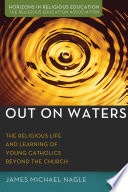disaffiliated student
Select an item by clicking its checkbox
Reviewed by: Susanna Cantu Gregory, Clarke University
Date Reviewed: June 22, 2021
Date Reviewed: June 22, 2021
For a denomination like Roman Catholicism that is canonically difficult to leave, many American Catholics are migrating beyond the institution’s immediate influence. The new religious patterns associated with this experience represent a somewhat cohesive movement influencing not just Catholicism, but the whole of North American religion. Careful examination of the lives of disaffiliating young adults reveals that their religious lives are complicated. For example, the assumption that leaving conventional ...
For a denomination like Roman Catholicism that is canonically difficult to leave, many American Catholics are migrating beyond the institution’s immediate influence. The new religious patterns associated with this experience represent a somewhat cohesive movement influencing not just Catholicism, but the whole of North American religion. Careful examination of the lives of disaffiliating young adults reveals that their religious lives are complicated. For example, the assumption that leaving conventional religious communities necessarily results in a non-religious identity is simplistic and even, perhaps, misleading. Many maintain a religious worldview and practice.
This book explores one “place” where the religiously-affiliated and religiously-disaffiliating regularly meet—Catholic secondary schools—and something interesting is happening. Through a series of ethnographic portraits of Catholic religious educators and their disaffiliating former students, the book explores the experience of disaffiliation and makes its complexity more comprehensible in order to advance the discourse of fields interested in this significant movement in religious history and practice. (From the Publisher)
This book explores one “place” where the religiously-affiliated and religiously-disaffiliating regularly meet—Catholic secondary schools—and something interesting is happening. Through a series of ethnographic portraits of Catholic religious educators and their disaffiliating former students, the book explores the experience of disaffiliation and makes its complexity more comprehensible in order to advance the discourse of fields interested in this significant movement in religious history and practice. (From the Publisher)
